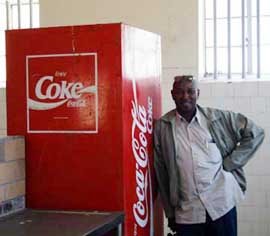 most of his 27 years in jail at the notorious Robben Island. I walked into the prison recently, eager for insight into conditions he must have endured in his quiet, but determined struggle to dismantle the Apartheid system in South Africa.
most of his 27 years in jail at the notorious Robben Island. I walked into the prison recently, eager for insight into conditions he must have endured in his quiet, but determined struggle to dismantle the Apartheid system in South Africa.A walk through cold corridors in the maximum security section revealed thick iron bars on narrow windows, blankets that served as bedding for Mandela and a bucket intended to use as a toilet in the cell in which the iconic African statesman languished in this wind swept island.
The dehumanizing hardships endured by South Africans jailed in the island, located 12 kilometers from Cape Town, failed to break their spirit or extinguish the clamor for equality in the country that now boasts Africa's largest economy.
Mandela is gone from Robben Island, but the jail remains as a towering testament to
"the triumph of the human spirit, of freedom and of democracy over oppression."
Robben Island, which was used between the 17th and 20th centuries
 as a leper colony, military base and prison - effectively home to those deemed as undesirable to South African rulers - was declared a U.N. world heritage site in 1999.
as a leper colony, military base and prison - effectively home to those deemed as undesirable to South African rulers - was declared a U.N. world heritage site in 1999.The trip to the island involved a ferry that carried more than 150 tourists to the historical site.
Walking from the quay, we immediately saw a building in which prisoners used to meet visiting relatives. A disused artillery gun was ahead.
A fleet of buses took us for a visit around the island, that is also home to penguins, seals, springboks, ostriches and other wildlife.
Finally, we walked into the prison, with one of the former inmates acting as a tour guide as he described condi
 tions in the facility during their incarceration and how prisoners in the maximum security section communicated with others using cooks to pass on messages and tennis balls stuffed with written notes.
tions in the facility during their incarceration and how prisoners in the maximum security section communicated with others using cooks to pass on messages and tennis balls stuffed with written notes.I walked into a cell next to that of Mandela's and locked the gate for a glimpse of the outside world from the wrong side of the thick iron bars. That brief experience showed that life must have been lonely and stressful for those who spent years in that place against their will.
The island is now a museum and wildlife sanctuary, a place where even Coca Cola gladly calls home - as seen from the large refrigerator standing in the prison's kitchen, bearing the global brand.